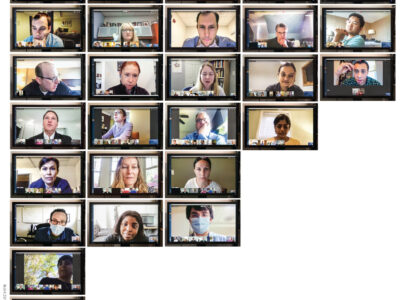
“I’m hopeful about the future of stem cells—but I have a lot of concerns,” Dr. John Gearhart was saying at a recent symposium on stem-cell research at Penn’s School of Medicine. The symposium, organized in honor of the newly endowed Emanuel and Robert Hart Chair for Bioethics, brought a mix of scholars, private-sector scientists, and journalists to examine the potential—and the daunting complexities—of this highly charged field.
Dr. Arthur Rubenstein, dean of the medical school, stressed the relevance of bioethics to contemporary science, and described the new chair as a “really important event” for the University. (It is held by Dr. Arthur Caplan, whose other titles include director of Penn’s Center for Bioethics and chair of the Department of Medical Ethics.)
“Ten or 15 years ago, people were yet uncertain as to whether ethics had a role in medicine,” Rubinstein added, “and look where we are now. There isn’t an aspect of medicine or biology that isn’t influenced, touched on, and inspired by ethics; and when it’s done on the very high level of the group of individuals of this soon-to-be department, we have a field at its very highest.”
Gearhart, an investigator at the Johns Hopkins Institute for Cell Engineering and professor of physiology at Johns Hopkins School of Medicine, suggested that while the ethics of stem-cell research is “manageable,” the science of it is “formidable.” As a result, the scientific community “has an obligation to educate the public regarding stem-cell technologies.”
He listed the stunning range of current experiments whose results are “consistent with stem cells working to counter various types of diseases.” His laboratory was the first to isolate and characterize human pluripotent stem cells from fetal germ cells, and he pointed out that in a laboratory setting, “we can take these cells and build virtually any type of neuron that we want—insulin-producing cells, cardiac-muscle cells, liver cells—and we’re having a lot of fun doing it. We’ve been able, in many cases, to take these cells and to graft them into various types of animal models, and have them survive and function.”
But exuberance can sometimes lead to breaches of research etiquette, Gearhart said. “More peer review is really sorely needed in this field. It doesn’t seem to matter anymore whether you publish something by peer review, or whether you call your favorite reporter and say, ‘Look what we’ve done,’ and publish it in the media. I’m very concerned about this.”
Gearhart also stressed the need for informed legislative control in the area of stem-cell research. “I’d like you to imagine for a moment what the progress would be if this were being done in hundreds of laboratories instead of just a few,” he remarked. “I feel very strongly that we need a legislative base in this country in which we can perform, or not perform, research in these areas. We should not leave it up to … our president to make these decisions.”
Dr. Glenn McGee, associate director for education at Penn’s Center for Bioethics, described stem-cell ethics as a tremendously complex field that takes in such issues as abortion, fetal tissue, cloning, transplantation, gene therapy, animal rights, aging, and the use of women in researching the role of pregnancy. “Some have compared it to the Alcahest—that mysterious magic substance of alchemy that can turn any metal into gold,” he said.
McGee focused on the ethical upshots of research involving human embryos, the source of most stem-cell lines; and also on the policy President George W. Bush announced last August, limiting all future stem-cell research strictly to those cell lines available as of that date. That policy raises “questions about encouraging procedures like abortion, or the complicity of researchers who use material from the creative process to do their research,” McGee said. “If a scientist engages in stem-cell research with material that was derived after President Bush’s speech from Crawford, Texas, is that person complicit in the destruction of the embryo? But once you start talking about making embryos [specifically for research purposes], it gets even more complicated.”
Spare embryos are often cryogenically frozen after a successful in-vitro fertilization, McGee pointed out. “They can remain in the freezer for a long time—up to nine years. But in general, it’s agreed upon by scientists that after about seven years, the discarded embryo is something else. Is it dead? Did it die in the freezer? Did it go from one form of suspended animation to another? What about destroying the embryos? … When after five days you put a little bit of acid on the developing embryo, and then those cells are moved to a patient in some attempt to treat some disease in the hopeful future, has the embryo really been destroyed, or would it fare better in that patient than it would in the freezer over the next seven years? It’s all very metaphysical, which is to say confusing or weird, and it’s hardly a matter which you’d expect the U.S. Senate or House, let alone its committees and lobbyists, to deal effectively with.”
Arti K. Rai, assistant professor of law at Penn’s Law School, noted that the University of Wisconsin holds the principal stem-cell patent, which is “extremely broad,” covering “all primate embryonic stem-cell lines, no matter how those lines are derived.” [For more on that, see “James Thompson and the Holy Grail,” January/February.] Furthermore, both Geron (a small biotech company) and the federal government hold rights to the patent because each, at some point, funded the research. Bush’s restrictions on new stem-cell lines have only handed more power to the patent holders.
In addition to the intellectual property that Wisconsin owns, Rai noted, “we now have tangible property in these all-important 60 or 70 cell lines owned by those who happened to have derived them by the arbitrary time of August 9th, 2001.”
According to Rai, this quasi-monopoly won’t prove beneficial to researchers. “The history of science suggests that innovations are best developed by variety,” she argued. “The swiftest progress achieved throughout the 20th century came through a variety of research.”
While Rai hopes that Wisconsin will ultimately act in the public interest and license the remaining rights to other scientists, it isn’t obligated to do so, she said. Given these restrictions, she suggested that “cures probably won’t be developed as quickly as we would like; or they may not, under certain circumstances, be developed at all.” They are also likely to be more expensive, given the number of people who “own intellectual property rights along the research path to the ultimate end cure.”
The prospect of profound innovation sometimes inspires feelings of anxiety, noted Antonio Regalado of the Wall Street Journal, who has been writing about bioethics since he visited Gearhart in his lab at Johns Hopkins in 1998. “I think concerning the questions of embryos and research, people are worried about the future of a technology that’s going to transform everything.” While Regalado may entertain a certain tolerance for that anxiety, he admitted that maintaining journalistic objectivity isn’t always easy—particularly when dealing with what he considers to be the often parochial opposition to stem-cell research.
“Every day we’re doing philosophy and bioethics by just talking about things,” said Dr. Harlan Weisman, an executive at the pharmaceutical firm of Johnson & Johnson. “We’re trying to convince [our] board of directors that stem-cell therapies are something that they should be involved in, and they’ve been very embracing. They feel it’s something they should be doing, and we’ve formed a committee which reviews research proposals. There is great promise beyond treatments, but also for diagnosis and the discovery of drugs.
“It’s been said that we will learn more about biology in the next two years than we have in the previous 10 decades—that’s how fast things are changing,” Weisman predicted. “This is a time of opportunity and excitement; a new century termed the Age of Biology, as opposed to the previous century, the Age of Physics.” And just because “it’s challenging work, because it’s complex,” he concluded, “doesn’t mean that we shouldn’t be doing it.”
—David Perrelli C’01




